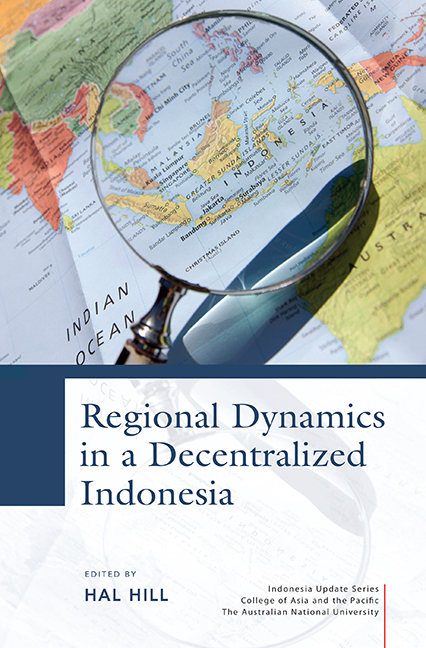Book contents
- Frontmatter
- Dedication
- Contents
- Tables
- Figures
- Contributors
- Acknowledgments
- Glossary
- Map of Indonesia
- 1 An introduction to the issues
- PART 1 HISTORICAL, ECONOMIC, POLITICAL AND SOCIAL PATTERNS
- PART 2 DECENTRALIZATION AND GOVERNANCE
- PART 3 LOCAL-LEVEL PERSPECTIVES
- PART 4 MIGRATION, CITIES AND CONNECTIVITY
- PART 5 CHALLENGES FOR INDONESIA'S PERIPHERY
- 17 The political impact of carving up Papua
- 18 Development in Papua after special autonomy
- 19 Special autonomy, predatory peace and the resolution of the Aceh conflict
- 20 Aceh's economy: prospects for revival after disaster and war
- Author index
- Subject index
- INDONESIA UPDATE SERIES
18 - Development in Papua after special autonomy
from PART 5 - CHALLENGES FOR INDONESIA'S PERIPHERY
Published online by Cambridge University Press: 21 October 2015
- Frontmatter
- Dedication
- Contents
- Tables
- Figures
- Contributors
- Acknowledgments
- Glossary
- Map of Indonesia
- 1 An introduction to the issues
- PART 1 HISTORICAL, ECONOMIC, POLITICAL AND SOCIAL PATTERNS
- PART 2 DECENTRALIZATION AND GOVERNANCE
- PART 3 LOCAL-LEVEL PERSPECTIVES
- PART 4 MIGRATION, CITIES AND CONNECTIVITY
- PART 5 CHALLENGES FOR INDONESIA'S PERIPHERY
- 17 The political impact of carving up Papua
- 18 Development in Papua after special autonomy
- 19 Special autonomy, predatory peace and the resolution of the Aceh conflict
- 20 Aceh's economy: prospects for revival after disaster and war
- Author index
- Subject index
- INDONESIA UPDATE SERIES
Summary
INTRODUCTION
The western part of the New Guinea islands is a unique part of Indonesia. Situated furthest from the nation's capital, Jakarta, it is Indonesia's most sparsely populated and geographically challenging region, and has some of the country's lowest socio-economic indicators. The combination of these difficult geographical and demographic conditions has meant that development in the region has always been challenging (Garnaut and Manning 1972, 1973; Manning and Rumbiak 1989).
Papua formally became part of Indonesia through a long and bitter process that took place between 1963 and 1969. At the time of annexation in 1969, the region was renamed West Irian (Irian Barat) and became a province of Indonesia, with Jayapura as its capital. In 1973, the name was again changed, to Irian Jaya. This controversial history led to the formation of movements among the local elites calling for Papua to become an independent state. Though relatively low level, sporadic and only intermittently violent, these independence movements have consistently challenged the legitimacy of Indonesian rule ever since (McGibbon 2006).
Over the ensuing decades, the Indonesian government attempted to weaken Papuan independence movements and accelerate development by allocating a higher level of funding per capita to Irian Jaya than to the other Indonesian provinces. Critics argued, however, that it was far less than the revenue generated by the region's natural resources. In particular, much of the revenue from the hugely profitable Freeport mine in Mimika district went straight to the central government, fuelling tensions between Jayapura and Jakarta (Resosudarmo et al. 2009a, 2009b).
The most critical time in the relationship between Jakarta and Jayapura was the period 1998–2001. The resignation of President Soeharto in mid-1998 and East Timor's successful demand for a referendum on independence intensified separatist hopes in Irian Jaya. When Abdurrahman Wahid became president at the end of 1999, he introduced a more accommodative and culturally sensitive approach to the question of ethnic conflict and separatist demands by changing the name of the province to Papua – the name by which parts of the main island were known before contact with the West (Sumule 2003; McGibbon 2004, 2006). To maintain good relations with the provincial elites, the president also endorsed the development of a draft bill on special autonomy for Papua.
- Type
- Chapter
- Information
- Regional Dynamics in a Decentralized Indonesia , pp. 433 - 459Publisher: ISEAS–Yusof Ishak InstitutePrint publication year: 2014



